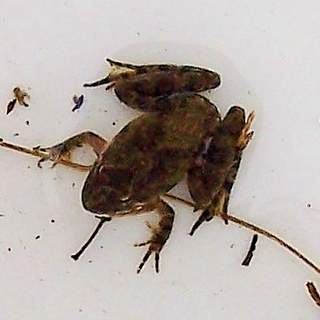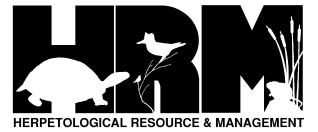Blanchard’s Cricket Frog
Overview:
Scientific Name: Acris crepitans blanchardi
Size: 0.6 – 1.5” (adult length)
Status: Rare and declining throughout range.
Michigan State Status: Threatened
MDNR Wildlife Action Plan Status: Species of Greatest Conservation Need

Habitat:
Usually found on edges of permanent bodies of water such as ponds, bogs, lakes, and sluggish rivers or streams. Will also occupy mud flats or sandy shorelines.
Adult Coloration:
Back may be brown, tan, olive, or gray, occasionally with patterning that can be green, reddish, or black. Usually with a broad light stripe down the center of the back. Two light bars extend from corner and edge of jaw to the eye, and pigment forming a dark triangle is often visible between the eyes. Often there will be a dark stripe from the shoulder to the groin, and another on the inside of each thigh. There may also be dark bands of pigment across the upper legs.
Adult Characteristics:
Very small frog with warty skin, long hind legs, and webbed hind toes. Toe tips are not obviously expanded. Snout is blunt but pointed. Males will have a thickened pad on the inside of the thumb and a vocal sac made apparent by gray mottling, although these characteristics are most visible during the breeding season. Voice: Call is similar to sound of pebbles being tapped together. Series of clicks that may last over 30 seconds. Usually begins at a slower tempo and increases. e.g., http://www.youtube.com/watch?v=aETYRw0MNMg
Larvae Characteristics:
Tadpoles are elongate and olive to brown with black speckling. Tail fins are narrow and tail has a distinctive black tip.
Species Confused With:
The Northern Spring Peeper is similar in size and shape, but it has smoother skin and usually an X-shaped mark on the back.
References:
- Amphibians and Reptiles of the Great Lakes Region by Jim Harding
- Harding, J.H. and J.A. Holman. 1992. Michigan Frogs, Toads, and Salamanders. MSU Cooperative Extension Service and MSU Museum. Extension Bull. E-2350, 144 pp.
- Ruthven, A. G., H. B. T. Gaige, et al. 1912. The herpetology of Michigan, by Alexander B. Ruthven. Crystal Thompson and Helen Thompson; Memoranda towards a bibliography of the archaeology of Michigan, by Harlan I. Smith; prepared under the direction of Alexander G. Ruthven. Lansing, Mich., Wynkoop Hallenbeck Crawford, State Printers.
- Holman, J. A. 2012. The Amphibians and Reptiles of Michigan: A Quaternary and Recent Faunal Adventure. Detroit, Mich., Wayne State University Press.
- Conant, R., and Collins, J. T. 1998. Reptiles and Amphibians: Eastern, Central North America. Houghton Mifflin Harcourt Press.
